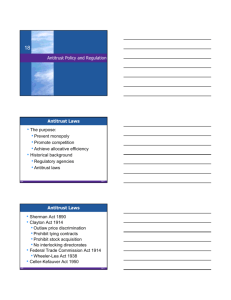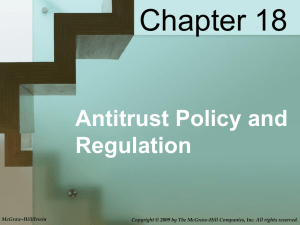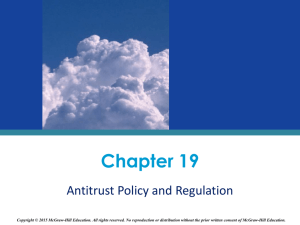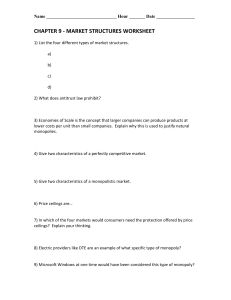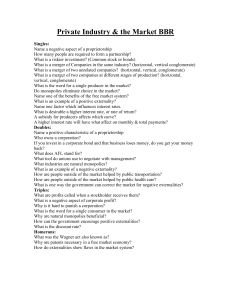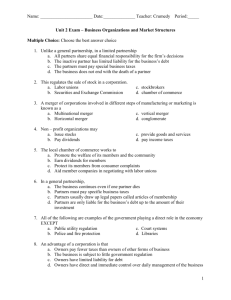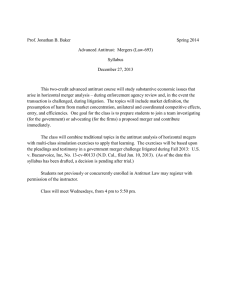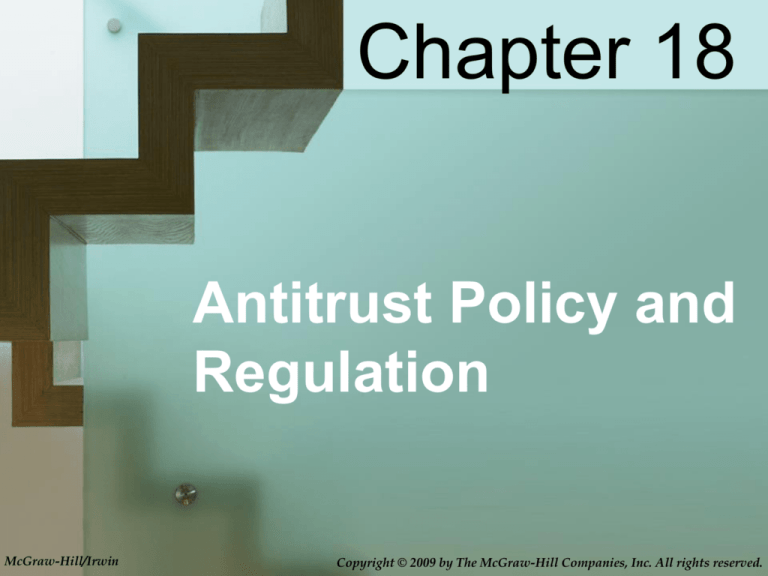
Chapter 18
Antitrust Policy and
Regulation
McGraw-Hill/Irwin
Copyright © 2009 by The McGraw-Hill Companies, Inc. All rights reserved.
Chapter Objectives
• Antitrust laws in the United
States
• Interpretation and application
of antitrust laws
• Natural monopolies
• Social regulation
18-2
Antitrust Laws
• The purpose:
–Prevent monopoly (and trusts)
–Promote competition
–Achieve allocative efficiency
• Historical background
–Regulatory agencies
• Natural monopolies
–Antitrust laws
18-3
Antitrust Laws
• Sherman Act 1890
– Illegal to monopolize or restrict trade
– Treble damages
• Clayton Act 1914
– Outlawed price discrimination when
unlinked to cost
– Prohibit tying contracts
– No interlocking directorates
18-4
Antitrust Laws
• Federal Trade Commission Act 1914
– Independent agency - investigate and
enforce
• Wheeler-Lea Act 1938
– Outlawed deceptive advertising
• Celler-Kefauver Act 1950
– Strengthened Clayton Act
Antitrust Policy
• Issues of interpretation
– Judges/administrations
• Monopoly behavior or structure
– 1911 Standard Oil Case
– 1920 U.S. Steel Case
– 1945 Alcoa Case
• The relevant market
– 1956 DuPont Cellophane Case
• Issues of enforcement
– Active vs. laissez-faire
– Creative destruction?
18-6
Effectiveness of Antitrust Laws
• Monopoly
–Microsoft Case
• Mergers
–Horizontal merger
–Vertical merger
–Conglomerate merger
18-7
Horizontal Merger
Horizontal Merger
Horizontal Merger
Vertical Merger
Who is the King of the Vertical
Merger in America?
Conglomerates
• Companies that operate four or more
distinct businesses, none of which
constitutes more than 50% of their total
revenue.
• Translation: Companies that do lots of
different “stuff”
Conglomerates
Types of Mergers
Automobiles
Blue Jeans
Conglomerate Merger
Blue
Jeans
Autos
A
T
B
U
C
V
Glass
Horizontal Merger
D
E
F
W X Y Z
Denim
Fabric
Vertical Merger
18-15
Effectiveness of Antitrust Laws
• Merger guidelines
– The Herfindahl Index
– Each case is specific…
– Horizontal vs. vertical vs. conglomerate
• Price fixing
• Price discrimination
– When restricting competition
• Tying contracts
18-16
Natural Monopoly
• Economies of scale
• Public utilities
– Electricity, water, gas, phone
• Solutions for better outcomes
–Public ownership
–Public regulation
–Public interest theory of regulation
• Low cost provided by natural monopoly
without low output/high prices prevalent
18-17
with monopolies
Industrial Regulation
• Regulators establish rates to give
natural monopoly “fair return”
• No incentive to reduce cost
• X-inefficiency
• Perpetuate monopoly
–Conditions of natural monopoly can
end without the regulated
monopoly itself ending
18-18
Social Regulation
• Applies “across the board” to all
industries
• Food and Drug Administration 1906
• Equal Employment Opportunity
Commission 1964
• Occupational Safety and Health
Administration 1971
• Environmental Protection Agency 1972
• Consumer Product Safety Commission
1972
18-19
Social Regulation
• Optimal level of social regulation
– Not easily quantified
• In support of social regulation
– externalities
• Criticisms of social regulation
– Regulatory capture -- comic
• Two reminders
– There is no free lunch
• Higher prices, less competition, less
innovation
– Less government is not always better than
18-20
more
United States vs. Microsoft
• Charged May 1998 under the
Sherman Act
• Accused of having a “Windows”
monopoly
• District court findings:
– Used anticompetitive means
• District court remedy
• Appeals court ruling
• Final settlement
18-21
Key Terms
• antitrust policy
• U.S. Steel case
• industrial regulation
• rule of reason
• social regulation
• Alcoa case
• Sherman Act
• DuPont cellophane case
• Clayton Act
• Microsoft case
• tying contracts
• horizontal merger
• interlocking directorates
• vertical merger
• Federal Trade Commission
Act
• conglomerate merger
• cease-and-desist order
• natural monopoly
• Wheeler-Lea Act
• public interest theory of
regulation
• Celler-Kefauver Act
• Standard Oil case
• per se violations
• legal cartel theory of
regulation
18-22
Next Chapter Preview…
Agriculture:
Economics and
Policy
18-23


